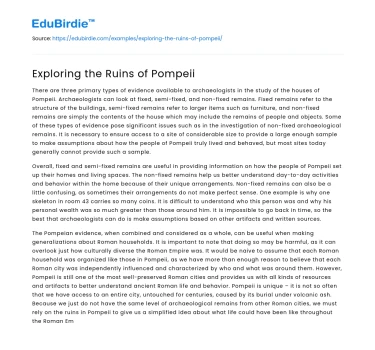There are three primary types of evidence available to archaeologists in the study of the houses of Pompeii. Archaeologists can look at fixed, semi-fixed, and non-fixed remains. Fixed remains refer to the structure of the buildings, semi-fixed remains refer to larger items such as furniture, and non-fixed remains are simply the contents of the house which may include the remains of people and objects. Some of these types of evidence pose significant issues such as in the investigation of non-fixed archaeological remains. It is necessary to ensure access to a site of considerable size to provide a large enough sample to make assumptions about how the people of Pompeii truly lived and behaved, but most sites today generally cannot provide such a sample.
Overall, fixed and semi-fixed remains are useful in providing information on how the people of Pompeii set up their homes and living spaces. The non-fixed remains help us better understand day-to-day activities and behavior within the home because of their unique arrangements. Non-fixed remains can also be a little confusing, as sometimes their arrangements do not make perfect sense. One example is why one skeleton in room 43 carries so many coins. It is difficult to understand who this person was and why his personal wealth was so much greater than those around him. It is impossible to go back in time, so the best that archaeologists can do is make assumptions based on other artifacts and written sources.
Save your time!
We can take care of your essay
- Proper editing and formatting
- Free revision, title page, and bibliography
- Flexible prices and money-back guarantee
The Pompeian evidence, when combined and considered as a whole, can be useful when making generalizations about Roman households. It is important to note that doing so may be harmful, as it can overlook just how culturally diverse the Roman Empire was. It would be naive to assume that each Roman household was organized like those in Pompeii, as we have more than enough reason to believe that each Roman city was independently influenced and characterized by who and what was around them. However, Pompeii is still one of the most well-preserved Roman cities and provides us with all kinds of resources and artifacts to better understand ancient Roman life and behavior. Pompeii is unique – it is not so often that we have access to an entire city, untouched for centuries, caused by its burial under volcanic ash. Because we just do not have the same level of archaeological remains from other Roman cities, we must rely on the ruins in Pompeii to give us a simplified idea about what life could have been like throughout the Roman Empire at that time.
Did you like this example?
Make sure you submit a unique essay
Our writers will provide you with an essay sample written from scratch: any topic, any deadline, any instructions.
Cite this paper
-
APA
-
MLA
-
Harvard
-
Vancouver
Exploring the Ruins of Pompeii.
(2022, December 15). Edubirdie. Retrieved December 25, 2024, from https://edubirdie.com/examples/exploring-the-ruins-of-pompeii/
“Exploring the Ruins of Pompeii.” Edubirdie, 15 Dec. 2022, edubirdie.com/examples/exploring-the-ruins-of-pompeii/
Exploring the Ruins of Pompeii. [online].
Available at: <https://edubirdie.com/examples/exploring-the-ruins-of-pompeii/> [Accessed 25 Dec. 2024].
Exploring the Ruins of Pompeii [Internet]. Edubirdie.
2022 Dec 15 [cited 2024 Dec 25].
Available from: https://edubirdie.com/examples/exploring-the-ruins-of-pompeii/
copy






 Stuck on your essay?
Stuck on your essay?

